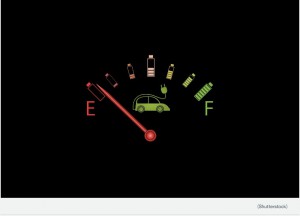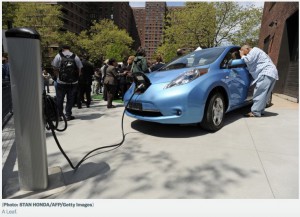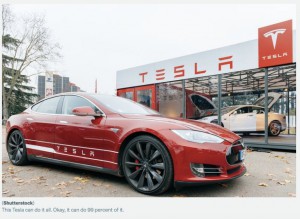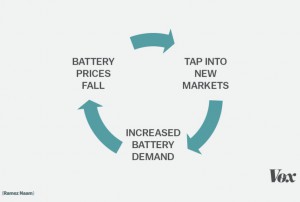“Range anxiety” is very rapidly going to become an anachronism.
A great deal of ink has been spilled on the subject of “range anxiety” — the fear, said to beset potential electric vehicle (EV) purchasers, that an EV just won’t go far enough, that it won’t be ready for that spontaneous road trip, that it will run out of juice at some inopportune moment.
Given the current state of EV technology and infrastructure, it’s not an entirely irrational fear. Most people can expect to have most-but-not-all of their transportation needs met by an EV — days that require 100-plus miles of driving, with no chance to recharge, are going to be a problem. Today’s EVs, at least the reasonably priced ones, work best as second cars.
But this is a temporary state of affairs, a window of time that is already closing. Multiple trends are converging that will wipe out range anxiety, relatively soon. In the meantime, EV advocates needn’t rend their garments over it, or worry overmuch about public-education campaigns. The problem will take care of itself.
EVs can already cover most trips for most people
We can start with a new study just published in Nature Energy by scholars at MIT and the Santa Fe Institute. Note 1.
It draws together the most sophisticated dataset yet about US vehicle trips. Chris Mooney at the Washington Post (Note 2) summarizes:
The current study is a modeling exercise based on an enormous amount of very fine grained data. That’s necessary because precisely how much energy an electric vehicle uses — and thus, how quickly it depletes its battery — depends not only on the distance driven but other subtle factors like the ambient temperature, the time spent idling, how rapidly the driver accelerates, and more.
The study thus combined together hourly temperature data in different U.S. regions, survey data on trip lengths, empirical data on the fuel economy of different cars, and on top of all of that, GPS-derived data on the speeds of actual vehicles and how they vary on a second-by-second basis.
With that data in hand, the researchers analyzed how well these trips could be handled by a modestly priced, currently available electric car — namely the 2013 Nissan Leaf — that’s charged each night, overnight.
A Leaf. (Photo: STAN HONDA/AFP/Getty Images)
The answer: 87 percent of current trips, with the 13 percent being daily travel that exceed the Leaf’s range of about 80 miles on a charge.
(By the way, 87 percent is the average, but the numbers clustered in a pretty tight range across geographies, regardless of per-capita gasoline consumption, which indicates that electric vehicles aren’t just for urban cores.)
EVs on the horizon can cover lots more trips
But here’s the twist. The authors also take a look at what the same car, with the same mass and volume, could do if it had a battery with 55 kWh of useful capacity, rather than the 2013 Leaf’s 19.2 kWh battery.
That car could displace 98 percent of daily trips.
Is a battery like that realistic? Yes! Simon Evans at Carbon Brief rounds up some options that already meet or exceed that capacity:
[T]he 2017 Volkswagen e-Golf will have a 39kWh battery, compared to 24kWh for the current model. The 2017 Chevy Bolt will have a 60kWh battery, similar to that rumored for the Tesla Model 3, and a 90kWh Tesla Model S is now on the market. Note 3.
That 90 kWh Tesla Model S has a range of about 270 miles on a full charge. Cars with that range will be sufficient for 99 percent of daily vehicle use, all but very long single-day trips, which are an anomaly. (And these can be boosted by roadside electric fast-chargers — see the next section).
This Tesla can do it all. Okay, it can do 99 percent of it. (Shutterstock)
Right now that Tesla is outrageously expensive. But we are just at the front end of a huge EV market expansion, which Tesla helped spark. Virtually every automaker is working on EVs now. (Here are 10 debuting this year). Note 4. The market is expanding rapidly. As it does, competition will bring prices down and performance up, just as it did for gasoline cars.
Batteries are getting cheaper and better, too. Note 5. Tesla’s getting ready to build a gigafactory “large enough to cover 107 NFL football fields with two to four floors of factory floor and workspace layered on top,” devoted entirely to mass producing batteries. Note 6.
As production scales up, what Ramez Naam calls the “energy storage virtuous cycle” kicks in: Prices fall; new markets for energy storage open up; new markets bring greater scale; scale brings more production and lower prices, etc. Note 7.
Ramez Naam
Analysts at Bloomberg New energy Finance (Note 8) expect electric cars to get cheaper than gas alternatives around 2022. Note 9. Along the way, batteries will get more powerful and energy dense and range will increase. A 90 kWh battery pack will go from the high end to the standard.
Other trends are chipping away at range anxiety
Meanwhile, Tesla and others are investing heavily in roadside fast-chargers to make highway travel in EVs more practical. Note 10.
And as I’ve written, wireless EV charging is also coming to mass market sooner than most people seem to think. Note 11. When charging becomes an automatic, hands-free affair, embedded into garages and parking spots, one of the last unfamiliar, effortful aspects of EV ownership (plugging it in) will be removed. Wireless charging will also be a boon to autonomous electric vehicle fleets. Note 12.
Shared vehicles are also on the horizon. Note 13. Elon Musk is already talking about building in the ability to share Teslas for extra cash; he’s talking about shared, autonomous buses. That’s great for city trips. The question is whether a shared long-distance ICE vehicle fleet can get organized to meet the need for that few percent of trips that still exceed EV range. The easier it is to get a car or truck for long-distance trips, the safer the decision to buy an EV will be.
My guess is that such a long-distance fleet won’t be needed for very long. EV range, infrastructure, and sharing are converging to cover more and more of the transportation needs of ordinary people. By the time my 12-year-old is driving, range anxiety will be like the anxiety we used to feel about having enough disk space to store our MP3s — little more than a curious generational marker.
Note 1. Zachary A. Needell, James McNerney, Michael T. Chang & Jessika E. Trancik , “Potential for widespread electrification of personal vehicle travel in the United States,” Nature Energy (2016). www.nature.com/articles/nenergy2016112
Note 2. Chris Mooney, ‘Range anxiety’ is scaring people away from electric cars — but the fear may be overblown,” The Washington Post (15 August 2016). www.washingtonpost.com/news/energy-environment/wp/2016/08/15/range-anxiety-scares-people-away-from-electric-cars-why-the-fear-could-be-overblown/?utm_term=.82b61bb5f829
Note 3. Simon Evans, “Anxiety about electric cars misplaced, says study,” Carbon Brief (15 August 2016). www.carbonbrief.org/anxiety-electric-cars-misplaced-says-study-2
Note 4. Eric Schaal, “10 Electric Vehicles Hitting the Market in 2016,” Autos CheatSheet (30 January 12106). www.cheatsheet.com/automobiles/10-electric-vehicles-hitting-the-market-in-2016.html/?a=viewall
Note 5. Megan Geuss, “Electric vehicle batteries are getting cheaper much faster than we expected,” ars Technica (16 July 2015). arstechnica.com/science/2015/07/electric-vehicle-batteries-are-getting-cheaper-much-faster-than-we-expected/
Note 6. Jordan Golson, “Tesla’s entire future depends on the Gigafactory,” The Verge (28 July 2016). www.theverge.com/2016/7/28/12299202/tesla-model-3-gigafactory-tour-elon-musk-photos-nevada
Note 7. Ramez Naam, “How Cheap Can Energy Storage Get? Pretty Darn Cheap.” (14 Oct 2015). rameznaam.com/2015/10/14/how-cheap-can-energy-storage-get/
Note 8. The Future of Energy Summit about.bnef.com/
Note 9. Damian Carrington, “Electric cars ‘will be cheaper than conventional vehicles by 2022’,” The Guardian (25 February 2016). www.theguardian.com/environment/2016/feb/25/electric-cars-will-be-cheaper-than-conventional-vehicles-by-2022
Note 10. Stephen Edelstein, “West Coast Electric Highway To Fill In California Fast-Charging Stations,” Green Car Reports (24 February 2016). www.greencarreports.com/news/1102523_west-coast-electric-highway-to-fill-in-california-fast-charging-stations
Note 11. David Roberts, “Wireless charging: the key to unlocking an electric vehicle revolution,” Vox (24 May 2016). www.vox.com/2016/5/24/11677684/wireless-charging-electric-vehicles
Note 12. David Roberts, “The transformative potential of self-driving electric cars,” Vox (25 Sept 2015). www.vox.com/2015/9/25/9398063/self-driving-electric-cars
Note 13. David Roberts, “Shared vehicles could make our cities dramatically more livable,” Vox (28 July 2016). www.vox.com/2016/7/28/12294214/shared-vehicles-livable-cities
Originally published in Vox (17 August 2016) at www.vox.com/2016/8/17/12494330/electric-car-range-anxiety
David Roberts writes, particularly well, about energy and climate change.






No comments yet, add your own below